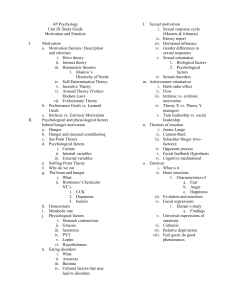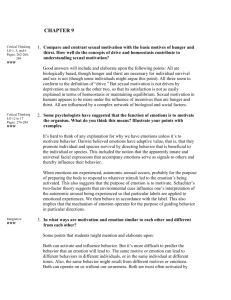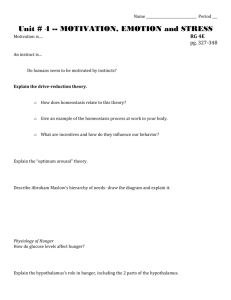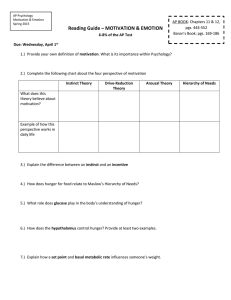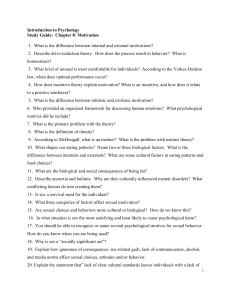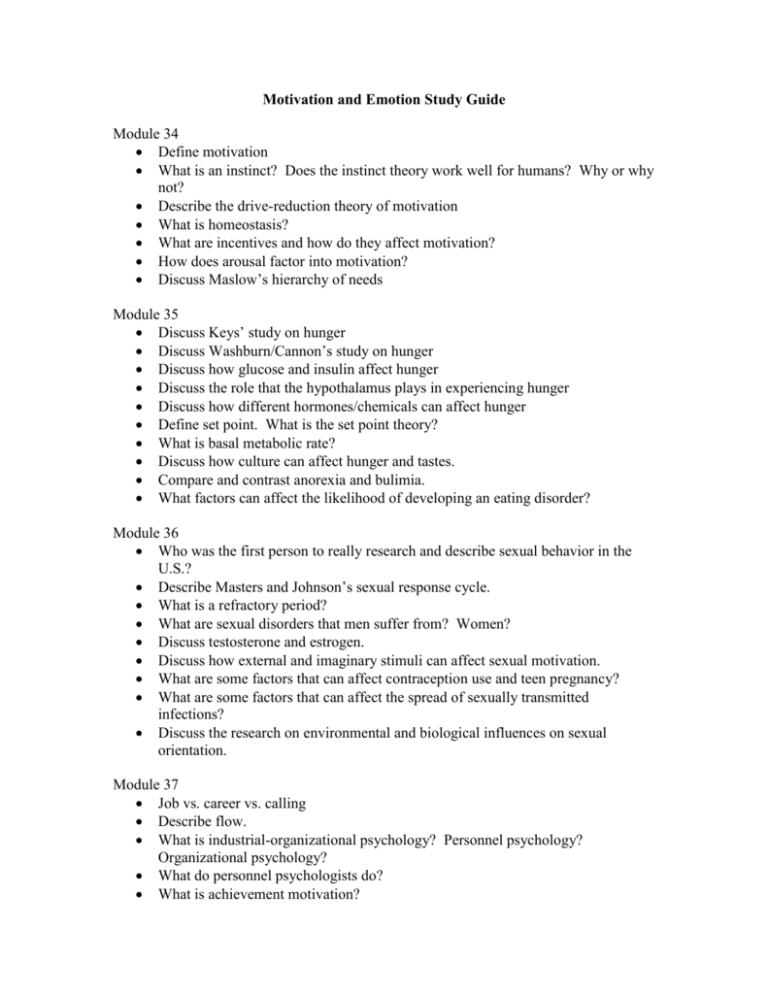
Motivation and Emotion Study Guide
Module 34
Define motivation
What is an instinct? Does the instinct theory work well for humans? Why or why
not?
Describe the drive-reduction theory of motivation
What is homeostasis?
What are incentives and how do they affect motivation?
How does arousal factor into motivation?
Discuss Maslow’s hierarchy of needs
Module 35
Discuss Keys’ study on hunger
Discuss Washburn/Cannon’s study on hunger
Discuss how glucose and insulin affect hunger
Discuss the role that the hypothalamus plays in experiencing hunger
Discuss how different hormones/chemicals can affect hunger
Define set point. What is the set point theory?
What is basal metabolic rate?
Discuss how culture can affect hunger and tastes.
Compare and contrast anorexia and bulimia.
What factors can affect the likelihood of developing an eating disorder?
Module 36
Who was the first person to really research and describe sexual behavior in the
U.S.?
Describe Masters and Johnson’s sexual response cycle.
What is a refractory period?
What are sexual disorders that men suffer from? Women?
Discuss testosterone and estrogen.
Discuss how external and imaginary stimuli can affect sexual motivation.
What are some factors that can affect contraception use and teen pregnancy?
What are some factors that can affect the spread of sexually transmitted
infections?
Discuss the research on environmental and biological influences on sexual
orientation.
Module 37
Job vs. career vs. calling
Describe flow.
What is industrial-organizational psychology? Personnel psychology?
Organizational psychology?
What do personnel psychologists do?
What is achievement motivation?
What is the relationship between satisfaction and engagement?
What are some different types of leadership? What are some effective
management techniques?
Module 38
What are the 3 components of emotions?
Describe the James-Lange Theory of Emotion.
Describe the Cannon-Bard Theory of Emotion.
Describe the Schacter-Singer Two-Factor Theory of Emotion.
Describe how the autonomic nervous system is related to emotions.
Describe how arousal and performance are related.
Describe the physiological similarities and differences among different emotions.
Discuss the problems with lie detectors.
What is the spillover effect? Give an example.
Does cognition precede emotion? Explain. Discuss the opinions of different
researchers (Zajonc, LeDoux, Lazarus, and Schacter-Singer)
Module 39
Are we better at deciphering positive or negative non-verbal expressions?
Are extraverts or introverts better at reading other people’s emotions?
What are some gender differences in reading and communicating emotions?
How good are we at detecting deceiving expressions? Discuss Ekman’s research.
Are facial expressions similar across cultures? Are gestures?
Discuss the facial feedback hypothesis.
Discuss the behavior feedback hypothesis.
Module 40
What are the 10 basic emotions Izard came up with? What emotion did Tracey
and Robins add? Which one did Shaver add?
What are the two dimensions of emotion?
How do we learn fear? Give an example.
What are some biological aspects related to fear?
What causes people to become angry?
What is catharsis?
Does venting reduce anger or increase anger? Explain.
What is the feel-good, do-good phenomenon?
What is subjective well-being?
Describe how positive and negative emotions vary over the course of a day.
Discuss how adaptability affects emotions.
Describe the relationship between wealth and happiness.
Describe the adaptation-level phenomenon.
Discuss relative deprivation.
How can we be happier? What should we do?


